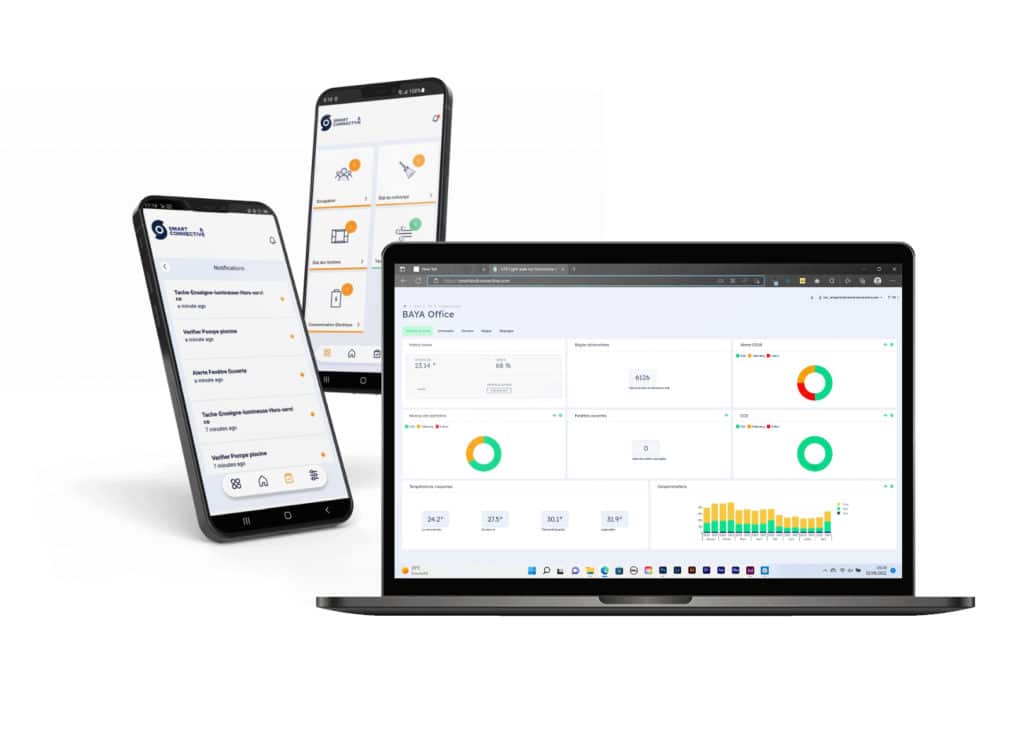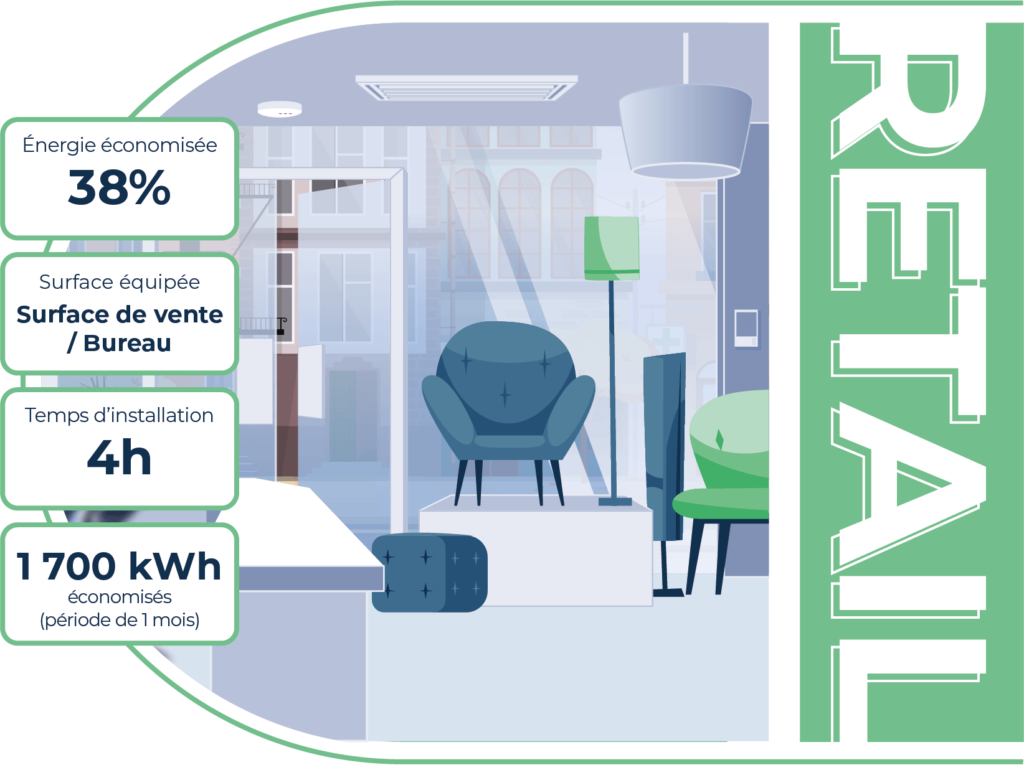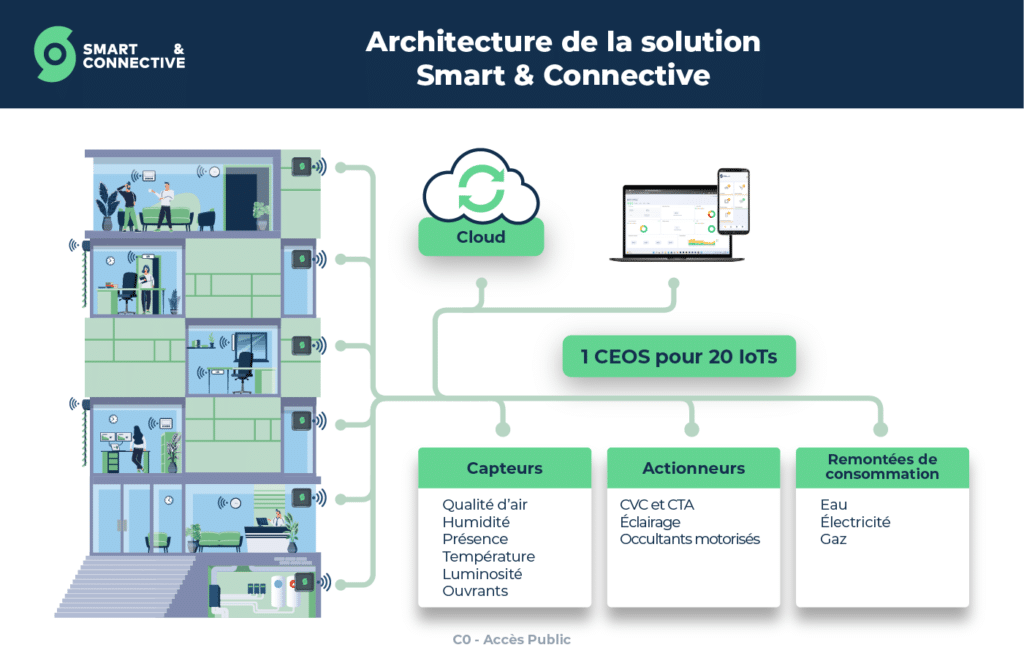
BMS : Optimising performance and sustainability
BMS : this acronym may not ring a bell, but it’s here to help you reduce energy waste in your commercial building, ensure the comfort of occupants and comply with the BACS Decree (another one that doesn’t ring a bell? We’ll come back to it later…).
In this article, we’ll be talking about building automation, its role and its specific features. We will also look at the regulatory framework for installing such a system. Finally, we’ll look at the issue of financing a BMS: its cost and the grants available.
What is Building Automation?
Definitions
BMS (Building Management System) is a computerised system for supervising the technical equipment in a commercial building. It consists of a PLC, sensors and actuators, and a control platform.
Building management systems can be used to control a wide range of equipment, particularly in industry. But today, when we think of BMS, we think mainly of their role in the energy efficiency of a commercial building, especially for lighter BMS. These BMS essentially control the HVAC and lighting according to human presence in the building, in order to limit energy wastage while maintaining a sufficient level of comfort for occupants.
Light BMS
At Smart & Connective, we call this GTB a Light BMS.
BMS should not be confused with BMS, or Centralised Technical Management.
Unlike a BMS, which controls all the technical units in a building, a BMS controls a specific technical unit (a single type of installation). A BMS can therefore be more specific, more advanced for a particular piece of equipment. A BMS, on the other hand, will be used to control the whole building, or even several buildings (multi-site management).
Standards and regulations
The decarbonisation and energy efficiency of buildings in France and Europe are the subject of much discussion, and several pieces of legislation are making reference. These include the RE2020 environmental regulations for construction.
“This is the first French regulation, and one of the first in the world, to introduce environmental performance into new construction via life-cycle analysis.”
As far as energy savings are concerned, the Tertiary Sector Decree imposes a gradual but significant reduction in energy consumption for tertiary sector buildings over 1,000m2.
The BACS Decree is an obligation of means, enabling tertiary buildings to meet some of the objectives of the Tertiary Decree. This decree requires commercial buildings to install a BMS to reduce energy wastage and optimise the building’s energy performance.
Standard NF EN ISO 52120-1: 2022 distinguishes 4 classes of BMS, based on the functions they perform and the impact they have on the building’s energy performance.
The 4 classes are :
- Class A: energy-efficient control and building automation systems
- Class B: advanced control and BMS
- Class C: standard control and BMS (reference)
- Class D: non-energy-efficient control and BMS systems
To comply with the BACS Decree, the installed BMS must be at least class C.
To qualify for EEC aid, the installed BMS must be class A or B.

Innovation in Building Management
What is Light BMS?

BMS Light meets the energy efficiency needs of small and medium-sized commercial buildings, as part of an energy renovation programme.
This type of solution is quick and easy to install. It’s an installation that doesn’t require any work, because Light BMS is non-wireless. This does not necessarily mean that the connected objects are not powered, but quite simply that the controller communicates with these IoTs (connected objects) without a wired connection. So there’s no need to cut holes in walls to “pull cables”. This reduces installation time and, above all, cost.
Light BMS is a solution:
- Quick to install
- Easy to handle
- Affordable
- Easy to maintain
- Easy to upgrade over time as needs change
- No work required
The Smart & Connective case
One of the strengths of Smart & Connective’s Light BMS is its grouped commands, which allow you to run a command in several places at the same time. For example, I have a hotel with 90 rooms and I want to switch on the heating in those that will be occupied this evening. I don’t need to go to each room to do this, I can just issue a group command for the heating from my online portal.
Another special feature of Light BMS Smart & Connective is the ability to upgrade the system remotely and en masse. CEOS PLCs and the various IoTs can be updated remotely and as a fleet. This greatly simplifies maintenance and ensures that the customer’s systems are always up to date with the latest features and improvements.
Internet of Things (IoT)
Light BMS is therefore a non-wireless solution, with a PLC that communicates with sensors and actuators to provide intelligent control by zone. This is known as “command and control”. To ensure that this control is as optimised as possible and delivers maximum energy savings, Smart & Connective BMS Light uses the Z-Wave and Zigbee radio protocols.
These radio protocols, widely used in home automation, are particularly well suited to energy efficiency in commercial buildings.

Multi-site management

One of the advantages of a Smart & Connective automation system for commercial buildings is the ability to control equipment remotely, on multiple sites and with grouped commands.
So, from your online portal, it’s very easy to view the real-time status of your buildings, receive any alerts (peak consumption, leaks, maintenance requirements, open door, etc.) and launch remote commands (in addition to the energy-saving scenarios already set up with an integrator).
Challenges and funding for a BMS
Turning constraints into opportunities
On average, a BMS can deliver energy savings of up to 30%, with potential savings of up to 50%, depending on the building and the equipment being controlled.
Depending on the type of building (hotel, office, shop, etc.), the installations and requirements will not be the same. So the price of the BMS, even Light, may vary. For example, a hotel will need more PLCs because it will need to equip each room with several connected objects (window opening sensor, presence sensor, intelligent thermostat, HVAC, etc.). It is therefore important to weigh up the cost of the BMS against the energy savings achieved.

Financing

To speed up the energy transition in buildings (particularly commercial buildings), the government has introduced a number of incentives, including Energy Savings Certificates (Certificats d’Économies d’Énergie).
GOOD TO KNOW
These CEEs (BAT-TH-116 form for installing or upgrading an automation solution) are multiplied by 1.5 or 2 depending on the work carried out. These bonuses are valid until 30 June 2024.

The little extra :
– A GTB Light installed quickly.
– No work required.
– Eligible for CEE.
– Multi-site hypervision if you manage several establishments.
